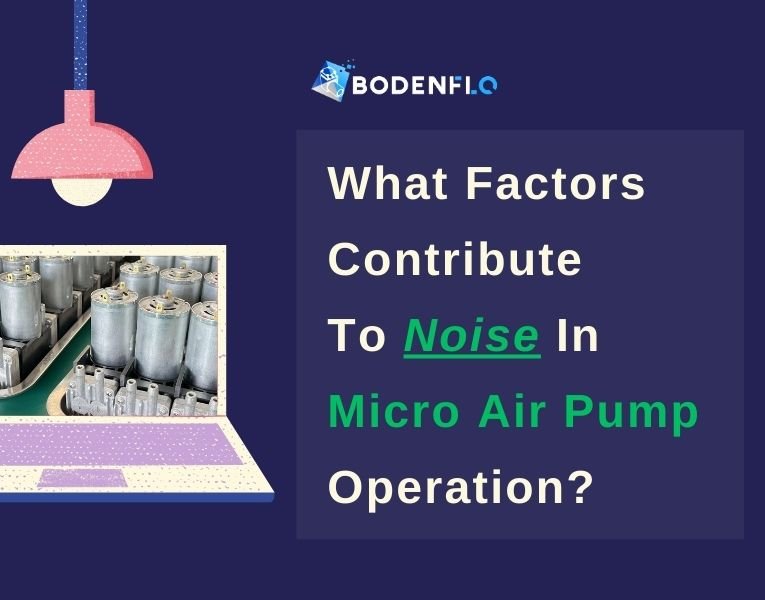
Are you wondering why micro air pumps, known for their compactness and efficiency, generate noticeable noise during operation? This seemingly minor aspect can significantly influence user experience and the suitability of these pumps in sensitive environments. Recognizing and addressing the sources of this noise is crucial, especially in settings like medical facilities or laboratories where quiet operation is paramount.
The primary contributors to noise in micro air pumps are mechanical vibrations, airflow turbulence, and the operating characteristics of the motor itself. These factors, combined with the materials used in construction and the pump’s assembly quality, can lead to varying degrees of noise output. Understanding these elements is key to designing quieter, more efficient pumps.
Maintaining a balance between efficiency and noise reduction in micro air pumps is a challenging yet essential task. This article aims to explore the various factors that contribute to noise in these pumps, offering insights and potential solutions to mitigate this common issue.
Mechanical Vibration: The Primary Noise Contributor
Mechanical vibration is the foremost contributor to noise in micro air pumps. These vibrations originate from the moving parts within the pump, such as the motor, gears, and oscillating diaphragm. The motor, particularly in types with brushes, inherently produces vibrations due to the interaction between electrical and mechanical components. Additionally, the diaphragm's movement, essential for air displacement, can cause vibrations that are amplified by the pump's casing and other structural elements. The interaction between these components can lead to resonant frequencies, further exacerbating noise levels. Understanding these vibrational dynamics is crucial in designing pumps with reduced noise output, involving careful selection of motor type, balancing of moving parts, and strategic design of the pump’s housing to dampen vibrations.
Air Flow and Turbulence
The flow of air through the pump significantly contributes to noise production, mainly when it causes turbulence. Turbulent air flow occurs when the air is forced through narrow or irregular pathways within the pump, leading to chaotic and noisy air movement. This is especially prevalent at points where the air changes direction abruptly or passes through components like valves or ports. The design of the pump's air pathway plays a crucial role in mitigating this noise source. Smooth, streamlined paths that minimize sharp turns and sudden changes in diameter can reduce turbulence. Additionally, the incorporation of features like diffusers or mufflers at the air outlet can further diminish noise caused by air flow. These design considerations are pivotal in developing quieter micro air pumps, ensuring efficient air movement while keeping noise to a minimum.
Vibration-Induced Noise: A Key Contributor
Vibrational noise in micro air pumps is a significant concern, especially in applications where noise sensitivity is critical. The source of this vibration-induced noise often lies in the mechanical operation of the pump itself. Internal components such as the motor, bearings, and even the diaphragm can produce vibrations as they operate. These vibrations can be transferred to the pump housing and then to the external environment, manifesting as audible noise.
Several factors influence the level of vibrational noise. The balance and alignment of rotating parts, the precision of component fit, and the material properties of the diaphragm and other moving parts play critical roles. For instance, an imbalanced motor or a diaphragm that's not uniformly flexible can create uneven forces that lead to increased vibration.
Mitigating this vibration-related noise requires meticulous engineering and design. Using high-quality, well-balanced motor components, ensuring precise assembly, and incorporating vibration-damping materials are effective strategies. Additionally, the pump can be mounted on shock-absorbing materials or isolators to reduce the transmission of vibrations to the surrounding structures. Addressing these factors is crucial for minimizing vibrational noise and enhancing the overall performance and acceptability of micro air pumps.
Material and Build Quality
The materials used in constructing a micro air pump, along with the build quality, are significant determinants of the noise level. Materials like metals and hard plastics, while durable, can amplify vibrations and noise. Conversely, using materials with inherent dampening properties, such as rubber or certain composites, can absorb vibrations and reduce noise. The build quality also plays a pivotal role. Pumps assembled with high precision ensure that components fit together seamlessly, minimizing gaps and misalignments that can lead to additional vibration and noise. The use of dampening mounts and insulation materials in and around the pump can also effectively reduce noise transmission. Selecting the right materials and maintaining high manufacturing standards are therefore key in developing miniature air pumps that operate quietly.
Electrical Noise from the Motor
The motor in a micro air pump, particularly if it is a brushed type, can be a source of electrical noise. This noise stems from the brushes as they make and break contact with the motor’s commutator, creating electrical arcing and subsequent noise. Additionally, the fluctuating electromagnetic fields in the motor can induce vibrations in metal parts, contributing to the overall noise. Advancements in motor technology, such as the use of brushless DC motors, have significantly reduced this noise source. Brushless motors offer smoother operation with fewer moving parts, leading to reduced mechanical and electrical noise. Incorporating these motors into micro air pump designs is increasingly common, as they offer not only quieter operation but also enhanced efficiency and longevity.
External Factors Influencing Noise Perception
External factors, including how the pump is installed and the characteristics of its operating environment, significantly influence the perception of noise. The mounting of the pump, for instance, can either dampen or amplify the noise. Rigid mounts can transmit vibrations to surrounding structures, while flexible, vibration-absorbing mounts can reduce noise transmission. The acoustic properties of the environment, such as room size, presence of sound-absorbing materials, and background noise levels, also affect how the pump’s noise is perceived. Careful consideration of these factors during installation can substantially impact the perceived loudness of the pump. Strategies like isolating the pump in an enclosure lined with sound-dampening materials or positioning it away from quiet areas can effectively reduce noise impact.
Conclusion
Effectively tackling the noise factors in micro air pumps is crucial for enhancing their design and ensuring quieter operation. At BODENFLO, our deep understanding of these elements allows us to engineer micro air pumps that not only adhere to the stringent demands of various noise-sensitive applications but also elevate the overall user experience. This commitment to reducing noise significantly extends the versatility and applicability of our pumps across multiple industries.
Contact our engineers for more noise reduction solutions. (info@bodenpump.com)


